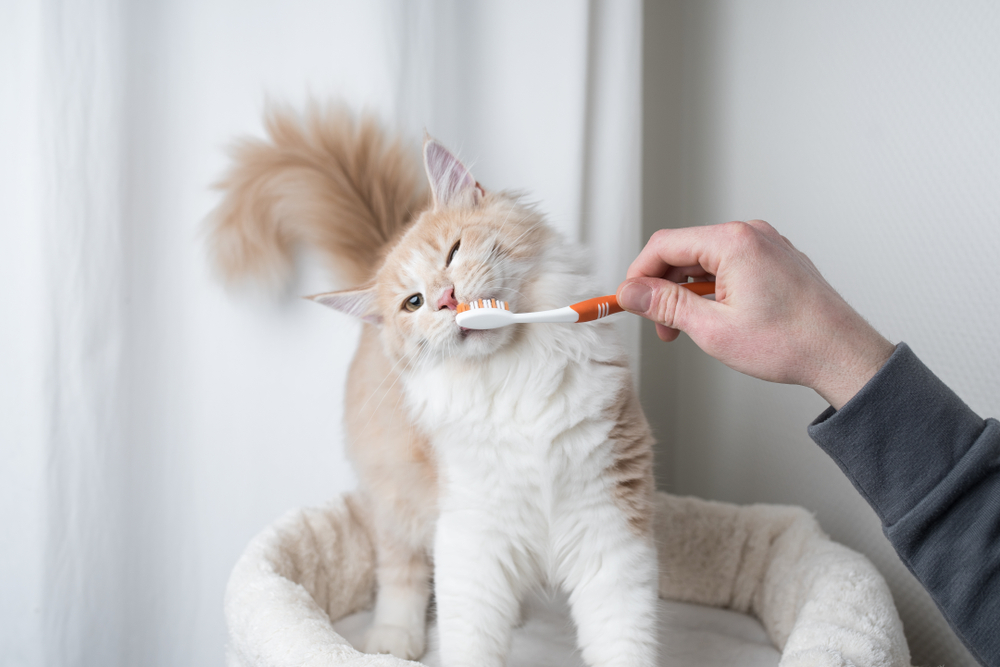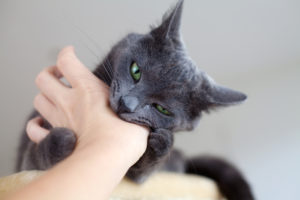For cat parents looking to maximize their kitty’s overall health, brushing your cat’s teeth should be a regular part of your routine to prevent dental disease in cats. While many dental treats and other products on the market claim to improve your cat’s dental health (and we’ll talk about those later!), tooth brushing remains the #1 way to keep your cat’s mouth healthy.
If You Have a Kitten…
Congratulations on welcoming a little kitten into your family! In addition to feeding her high-quality kitten food, enjoying play sessions, socializing your little kitty, and providing her with places to rest and relax, it’s the perfect time to get her used to having her mouth handled and teeth brushed.
Your kitten has baby teeth that will fall out when she is four to six months old to make room for her adult teeth. However, the time and effort invested in creating a positive tooth-brushing experience will help you avoid common cat teeth problems and preserve her adult pearly whites for as long as possible!
If You Have an Adult Cat…
If you have decided to start brushing your adult cat’s teeth for the first time, congratulations! This is a big step that will go a long way to helping your cat lead a longer, happier, and healthier life.
Before you start your tooth-brushing journey, it’s a good idea to have your cat examined by his veterinarian to make sure that there are no painful lesions in your cat’s mouth. Once your veterinarian gives you the approval to start brushing, follow the steps below to make it as fun and productive as possible!
Brushing Your Cat’s Teeth
The most important goal to keep in mind when brushing your cat’s teeth is:
KEEP IT POSITIVE!
As soon as your cat starts to struggle or indicates they are not having a good time, end the session and reward him with their favorite treat. It is counterproductive to continue to try to wrestle with your kitty and force them to comply with tooth-brushing since this will only create negative emotional associations with the activity.
With the goal of “keep it positive” in mind, the second-most important rule is:
TAKE IT SLOW.
Start with your finger and a small bowl of tuna juice, chicken broth, flavored pet toothpaste, or a liquid cat treat. (Note: Never use human toothpaste for your cat’s tooth brushing—if swallowed, it can cause medical problems.) Coax your kitty to your lap and praise them. We bet you already know a secret spot they love being rubbed—use this knowledge to relax them, since we want to—you guessed it—KEEP IT POSITIVE!
Once your kitty is happy on your lap, dip your finger in the bowl of yummy liquid/toothpaste and let her lick it off. After a few happy licks, move on to using your flavored finger to start massaging your cat’s gums/teeth, then give her a few more licks from the tip of your finger.
Note: when massaging your cat’s gums, keep your finger between your cat’s lips/cheeks and their teeth. NEVER try to brush your cat’s teeth from the “tongue side” of the teeth—it’s not possible to do this with an awake cat.
Keep alternating between having your cat lick the tasty liquid from your finger and rubbing her teeth, gradually increasing the amount of time your kitty allows you to rub inside of her mouth. Once your cat starts squirming, or if you feel like you’ve made good progress, praise your cat and offer her a favorite toy or treat. Try doing this each day and extending the amount of time your cat lets you “brush” their teeth with your finger.
Add Texture
Once your cat is happily hopping on your lap, expecting some quality time and yummy rewards, it’s time to add some texture! You can do this by wrapping a piece of a light towel or a piece of gauze around your finger before dipping it in the liquid. Again, allow your kitty to lick the flavored broth/treat off of your texturized finger before gradually increasing the amount of gum/tooth massage he will let you perform.
Finally, once your cat tolerates (and even looks forward to) sessions using a texturized finger, it’s time to move onto the toothbrush. This can be a finger brush commonly sold for pets, a pet-specific toothbrush with a longer handle, or a children’s toothbrush you purchase at your local grocery store. Choose based on whatever is easiest for you to use!
Introduce your cat to the toothbrush, again by keeping it positive! Dip the toothbrush bristles in your pet toothpaste, broth, or liquid cat treat and let your cat lick it off the brush. (He might even love the texture and start gnawing on the bristles!) Praise your kitty, pet him, and gradually use the brush inside of your cat’s mouth, just as you did with your finger.
Your goal should be to brush your cat’s teeth for about 1 minute on each side of his mouth. While brushing your cat’s teeth every day would be a phenomenal goal, most cat owners are only able to squeeze this activity in two to three times a week—and that is perfectly fine! ANY tooth-brushing session for your cat will have a positive impact on their dental and overall health.
After EVERY tooth-brushing session, no matter how productive or short—make sure to reward your cat with his favorite treat or some playtime with a favorite toy.
What About Dental Treats/Chews/Water Additives?
If you’ve been shopping for pet supplies, you have undoubtedly noticed the overwhelming number of treats, chews, and water additives that are advertised as having dental care benefits. Unfortunately, there are no universal standards for labeling these products, so companies can use these terms without actually knowing whether they help your pet’s teeth.
Fortunately, there is an independent laboratory that tests these products. If a product is proven to reduce plaque and tartar accumulation by a significant amount, the lab authorizes placing a special logo on the product’s packaging. This laboratory is called the Veterinary Oral Health Council (VOHC) and you can find a list of accepted pet products on their website. These certified treats and water additives can be helpful additions to your cat’s oral healthcare routine.
However, none of these products are as effective as brushing your cat’s teeth. If your cat just won’t tolerate having his teeth brushed, or if you don’t feel comfortable with the process, then products with the VOHC seal of approval can still help your kitty’s dental health.
The Bottom Line
Training your cat to tolerate toothbrushing is one of the best things you can do for his overall health and stinky breath. If brushing your kitty’s teeth doesn’t solve the problem, read our guide to “why does my cat’s breath stink?” Whether you have a young kitten or an adult cat, it’s never too early—or too late!—to start taking care of your cat’s teeth!
Our AskVet Veterinarians are available to discuss all of your pet’s needs 24 hours a day, 7 days a week. Whether you have an immediate need or are looking to improve your pet’s overall wellbeing, just sign into your pet app account and one of our friendly and knowledgeable veterinary experts will attend to your needs, no appointment required!
Written by:
Allison Ward, DVM
Dr. Allison Ward grew up in the suburbs of Washington, D.C. and started working in veterinary hospitals when she was 14 years old. After graduating from veterinary school in 2011, she completed a small animal rotating internship in New Jersey, followed by a neurology/neurosurgery internship in Miami. After completing this advanced training, Dr. Ward then moved on to general small animal practice. Dr. Ward’s professional interests include feline medicine, neurology, and pain management. Her passion for educating pet owners carries over into her work with AskVet, and she loves being able to help pets and their parents at all times of the day (and night!). She currently resides in sunny south Florida with her two cats, Larry and George.








